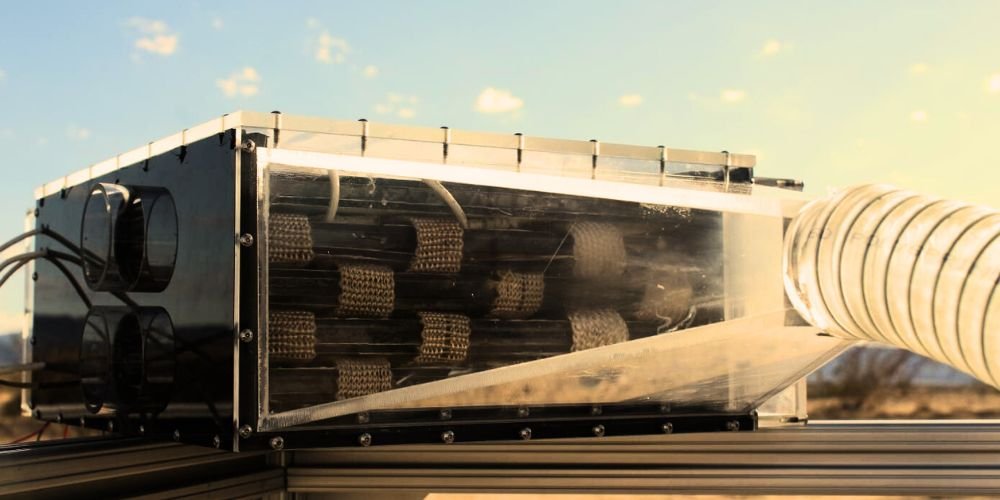Atmospheric water harvesting has emerged as a promising solution to augment freshwater supplies in the face of escalating water scarcity and climate change-induced droughts. By leveraging innovative technologies, it enables the capture and utilization of water vapor from the atmosphere, providing a sustainable and decentralized approach to water production. This article delves into atmospheric water harvesting, uncovering its principles, applications, and potential to address pressing water challenges worldwide.
Understanding Atmospheric Water Harvesting
Atmospheric water harvesting, also known as atmospheric moisture harvesting or air-to-water technology, involves extracting water vapor from the air and converting it into liquid water for various uses. The process capitalizes on the natural hydrological cycle, wherein water evaporates from oceans, lakes, and rivers, forms clouds, and condenses into precipitation. It mimics this cycle by artificially condensing water vapor to produce fresh water.
Condensation Techniques
Various condensation techniques are employed in atmospheric water harvesting systems to facilitate the conversion of water vapor into liquid water:
- Cooling condensation: This method involves cooling the air below its dew point temperature, causing water vapor to condense into droplets on a surface or within a condensation chamber.
- Desiccant-based condensation: Desiccants such as silica gel or zeolite absorb moisture from the air, which is then extracted and condensed into liquid water through heating or cooling processes.
- Membrane-based condensation: Semi-permeable membranes selectively pass water vapor while blocking other gases, enabling the separation and collection of condensed water vapor.
Collection and Purification
Once water vapor is condensed into liquid form, it is collected and subjected to purification processes to ensure its quality and safety for consumption. Filtration, UV sterilization, reverse osmosis, and distillation are commonly employed methods to remove impurities, microbes, and contaminants from harvested water, producing potable or non-potable water depending on the intended use.
Applications of Atmospheric Water Harvesting
Atmospheric water harvesting holds diverse applications across various sectors:
Drinking Water Supply
Atmospheric water harvesting provides a decentralized and resilient source of drinking water, particularly in arid and water-stressed regions where traditional water sources are scarce or unreliable. It can complement existing water supply systems, serve as an emergency water source during disasters, and enhance community resilience to droughts and water shortages.
Agriculture and Irrigation
It can be utilized for agricultural irrigation, enabling farmers to sustain crop growth and productivity in regions with limited access to freshwater resources. By supplementing irrigation water supplies with harvested atmospheric water, farmers can mitigate the impact of droughts, reduce reliance on groundwater pumping, and promote sustainable agricultural practices.
Industrial and Commercial Applications
It finds applications in various industrial and commercial sectors, including manufacturing, tourism, and construction. It can meet water demand for industrial processes, cooling systems, landscaping, and recreational facilities, reducing reliance on municipal water supplies and alleviating strain on local water resources.
Advancements in Atmospheric Water Harvesting Technology
Recent advancements in atmospheric water harvesting technology have expanded its feasibility and scalability:
Solar-powered Systems
Solar-powered atmospheric water harvesting systems utilize solar energy to drive condensation processes, making them suitable for off-grid and remote locations with abundant sunlight. Solar collectors, photovoltaic panels, and solar thermal collectors are integrated into harvesting systems to provide energy for cooling, heating, and purification processes.
Hybrid Systems
Hybrid atmospheric water harvesting systems combine multiple condensation techniques, such as cooling condensation and desiccant-based condensation, to maximize water production efficiency and reliability. By integrating complementary technologies, hybrid systems can operate in a wider range of environmental conditions and achieve higher water yields than single-stage systems.
Scalability and Modularity
Advances in modular design and scalability have made atmospheric water harvesting systems adaptable to diverse settings and water demand levels. Modular components, such as condensation units, storage tanks, and purification systems, can be easily scaled up or down to meet specific water requirements, making them suitable for small-scale and large-scale applications.
Challenges and Future Directions
Despite its potential, atmospheric water harvesting faces several challenges and opportunities for further development:
Energy Efficiency
Energy consumption and operating costs remain key challenges for atmospheric water harvesting systems, particularly in humid environments with low-temperature differentials. Research efforts focus on improving energy efficiency through optimizing condensation processes, utilizing renewable energy sources, and developing advanced materials and coatings.
Water Quality and Safety
Ensuring the quality and safety of harvested atmospheric water is essential to prevent contamination and ensure compliance with drinking water standards. Ongoing research aims to develop robust purification technologies, monitoring systems, and quality control measures to safeguard consumers’ health and promote trust in atmospheric water harvesting.
Environmental Considerations
Assessing the environmental impacts of atmospheric water harvesting, including energy consumption, carbon emissions, and land use, is critical to ensure its sustainability and minimize unintended consequences. Life cycle assessments, environmental impact studies, and regulatory frameworks are needed to guide the responsible deployment and management of atmospheric water harvesting systems.
Conclusion
Atmospheric water harvesting offers a sustainable, innovative, and versatile approach to water production, offering a lifeline to communities facing water scarcity and climate-related challenges. With ongoing advancements in technology, research, and policy support, atmospheric water harvesting has the potential to complement traditional water sources, enhance water resilience, and promote equitable access to safe and reliable drinking water worldwide. As we harness the power of the atmosphere to harvest water, the journey toward a water-secure future shines brightly, guided by the promise of innovation, collaboration, and environmental stewardship.












